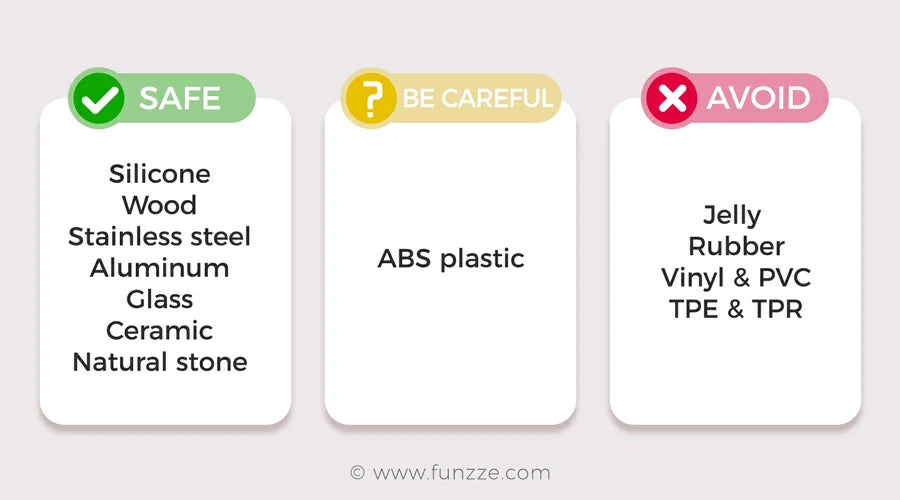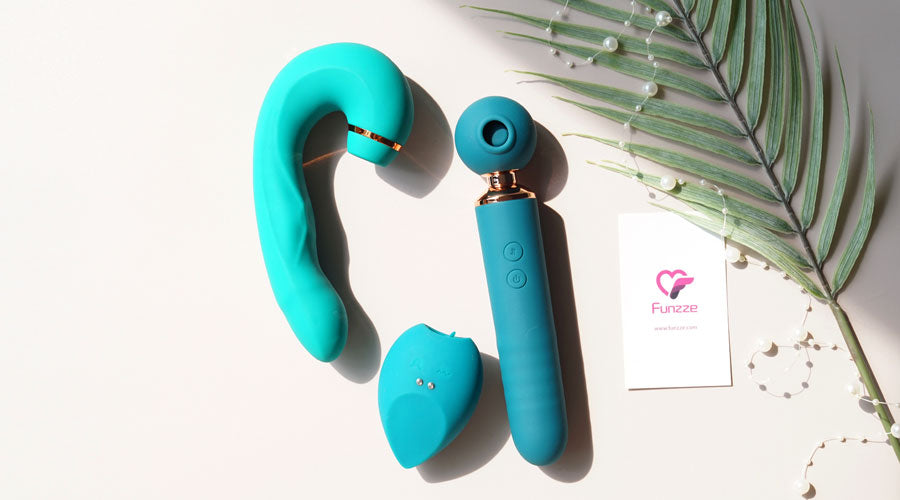
TABLE OF CONTENTS
- Preface
- Science of Material Safety
- Materials Used in Adult Toys
- Silicone
- Jelly, Jellee, and Gel
- TPE and TPR
- Vinyl and PVC
- ABS Plastic
- Metal
- Glass
- Ceramic
- Wood
- Natural Stone
- Rubber
- How to Choose Safe Products
- Choose Non-porous Materials
- Avoid Toys with a Strong Chemical Smell
- Purchase from Trusted Brands and Manufacturers
- In the End
Preface
Engaging in the world of adult toys isn’t as simple as it once was. With a myriad of products available, the material used in creating these toys is of utmost importance. Why? The reason is simple and twofold: safety and pleasure. A good adult toy is made from materials that not only give you satisfaction but also ensure your well-being.
While adult toys have become more popular in recent years, they're not a new invention. They've existed for thousands of years, but the materials used to create them have substantially changed over time. Early incarnations of sex toys were made from stone, leather, and even wood. Eventually, rubber and latex were introduced, providing more comfort. The most recent advancement in the adult toy industry has been the shift to body-safe materials like silicone, glass, metal, and ABS plastic. This shift indicates a growing recognition of the importance of safe, non-porous, and easy-to-clean materials.
When referring to intimate toys, material safety becomes a primary concern. Safe materials ensure no toxic substances are leaching into your body. Toys of low-quality and unknown material composition can potentially carry dangerous substances such as phthalates, which are linked to an array of health problems like hormone disruption, infection and even cancer.

Science of Material Safety
Material safety revolves around three main aspects: biocompatibility, porosity, and the presence of harmful chemicals.
Biocompatibility
Biocompatibility refers to how well a material interacts with the human body. A biocompatible material, like medical-grade silicone, is designed to coexist with the body without causing a reaction or harm. Poor biocompatibility can result in allergic reactions or infections.
Harmful Chemicals
Materials used in adult toys also need to be free from harmful chemicals. Certain toys made from jelly rubber or PVC often contain phthalates, a group of chemicals used to increase flexibility. But studies have shown that phthalates can disrupt hormones and may be linked to various health problems. More reputable companies have now phased out the use of phthalates, but there are still products on the market that contain them.
Current state of regulation in the industry varies greatly from country to country, and unfortunately, it's often under-regulated. Therefore, it's important for consumers to do their research and choose products from reputable companies that prioritize safety.
Porosity
The porosity of a material (its level of porousness) is another vital factor in its safety. Non-porous materials like silicone, metal, glass, and certain plastics are safer because they don't harbor bacteria after cleaning, as discussed in detail in this research paper. This contrasts with porous materials, which have micro-pores where bacteria and other pathogens can dwell even after cleaning. This makes thorough sanitation impossible and can lead to infections.
Pro Tip: Non-toxic does not mean the material is fully safe. Porous materials, both toxic and non-toxic, cannot be cleaned thoroughly beyond the surface. Over time, these toys can become bacterial breeding grounds and potentially cause infections.
Materials Used in Adult Toys
According to a study published on NCBI, some sex toys could break down into microplastics, and the materials might contain phthalates which have been linked to health risks. This makes the choice of material for adult toys especially important.
Body-safe adult toys are characterized by two key features: they are non-porous and non-toxic. Being non-porous means that the surface of the toys doesn't have microscopic holes where bacteria and fungi can reside. Non-toxicity ensures that the materials used in production are free from harmful chemicals that could potentially leach into the body.
So, let's take a look at what materials adult toys are made from.
Silicone
Silicone is a synthetic polymer made up of silicon, oxygen, carbon and hydrogen. It's popular in the adult toy market for its varied benefits. As observed in the study “Safety testing of adult novelties using in vitro methods”, silicone is highly suitable for use in these products due to its unique properties. Silicone has a high temperature resistance, which allows it to be sterilized by boiling or in a dishwasher. It's also non-porous, meaning it won't harbor bacteria or fungi once it's been cleaned. Furthermore, silicone can feel like skin, which is why it’s used for realistic-looking toys.
Jelly, Jellee, and Gel
Jelly-like materials are used in adult toys for their softness and affordability. However, However, it's important to note that these materials have received criticism over the years for safety reasons. They mainly contain PVC softened with phthalates to increase flexibility, which are linked to health concerns. These toys are porous, thus can harbor bacteria even after cleaning. Furthermore, these toys aren't heat resistant and can't be sterilized by boiling. It is highly recommended to use a condom with these toys to lower the risk of direct contact with potentially harmful substances.
TPE and TPR
TPE (Thermoplastic Elastomers) and TPR (Thermoplastic Rubbers) are types of polymers - substantial, chain-like molecules derived from smaller entities known as monomers. Predominantly employed in the manufacturing of adult toys, they are appreciated for their softness and expandability. Although they are considered non-toxic, some studies such as "Microbial susceptibility of various polymers..." suggest that these porous materials have the potential to harbor bacteria, and are often combined with chemicals that may pose harm. It is observed that these materials degrade over time, usually within a few months. Signs of deterioration include tearing, the appearance of black spots, or an unpleasant smell, indicating the need for replacement.
Pro Tip: It is recommended to replace such toys every 8-10 months.
Vinyl and PVC
Vinyl, or Polyvinyl Chloride (PVC), is used in adult toys for its affordability and ability to manifest as soft yet firm products. Yet, it's porous and difficult to clean, making it a potential harbor for bacteria. PVC toys also often exude a strong plastic smell, a sign of the chemical plastic softeners known as phthalates used in their construction. Although phthalates enhance flexibility, they leach out over time, especially under heat, exposing users to potential health risks.
ABS Plastic
ABS plastic, a non-toxic thermoplastic, is widely used in adult toys for its durability, impact resistance, and smoothness. Although it's not entirely non-porous, it's less porous than materials like TPE or TPR, making it generally safe. Its rigidity contributes to intense vibrations, making it a great material for bullet vibrators or plastic handles. Thorough cleaning of ABS plastic toys is essential to prevent potential bacterial build-up in its microscopic pores. Regular surface checks are also recommended to ensure ongoing comfort and safety.
Metal
Adult toys made of metal - usually stainless steel or aluminum - offer a unique set of properties. These heavy, rigid, and temperature reactive toys are body-safe because they're non-porous and can be completely sterilized. Metals like stainless steel and aluminum can also provide a representation of luxury or kink aesthetic.
Glass
Borosilicate glass, typically used in making adult toys, is a type of glass with silica and boron trioxide. This type of glass is thermal shock resistant, non-porous, and body-safe. Since it's non-porous, it's easy to clean and sterilize, and doesn't harbor bacteria or fungi. Glass toys also offer a unique sensation due to their hardness and smoothness. Despite all these advantages, it's important to examine glass toys before each use, looking for any cracks or chips that could potentially cause injury.
Ceramic
Ceramic is another material that has made its way into the adult toy industry due to its unique characteristics. Ceramics used for these toys typically include natural clays fired at high temperatures and then glazed with a non-porous, body-safe finish, making them non-toxic, phthalate-free, and hypoallergenic. One key aspect of ceramic toys is the glaze used - it must be lead-free to ensure safety. And, like glass, ceramic toys should be checked for any cracks or chips before every use for safety reasons.
Wood
Wooden adult toys are made from types of wood, such as pine, cedar, oak, or mahogany. Though wood is naturally porous, wooden adult toys can be extremely safe provided that a medical-grade finish is applied. Each wooden toy is unique due to the unique wood grain patterns. With consistent proper care, these toys can serve as a sustainable and unique addition to your collection.
Natural Stone
Natural stone adult toys, typically made of smoothed granite, obsidian, or jade, offer a unique and sensory experience due to their weight, hardness, and ability to retain temperature. These toys are non-porous, meaning it's easy to clean and less likely to harbor bacteria or fungus. However, these toys need to be polished to a smooth finish to ensure safety and comfort. Regular check-ups are necessary to detect any wear or tear.
Rubber
Rubber, includes both natural and synthetic types, is used in adult toys. Natural rubber, known as latex, is derived from tree sap. It's flexible and malleable, but is porous and can house bacteria. Also, it can cause allergic reactions in some individuals. Synthetic rubber is man-made from petroleum byproducts. Its properties, such as softness and flexibility, can vary significantly. Like latex, synthetic rubber is porous. While versatile, rubber's porous nature and potential allergenicity are worth considering when purchasing such toys.
How to Choose Safe Products
To ensure a safe and pleasurable experience, it's crucial to know how to choose the right adult toys. Here are some important points to consider:
Choose Non-porous Materials
As mentioned earlier, materials such as body-safe silicone, ABS plastic, stainless steel, and borosilicate glass are great options. Porous materials can harbor bacteria, leading to infections. Therefore, choosing non-porous materials, which can be thoroughly cleaned and sterilized, is an important step toward safety.

Avoid Toys with a Strong Chemical Smell
A toy that emits a strong chemical smell should raise a red flag. This smell could indicate the presence of harmful chemicals like phthalates. No matter how thorough the cleaning, it's difficult to be rid of this smell, and it's safer to avoid such toys.
Purchase from Trusted Brands and Manufacturers
Countless companies manufacture adult toys, but not all of them prioritize users' health. To ensure body-safe product purchases, it is advised you stick with trustworthy brands and retailers endorsed by sex toy reviewers. These brands are likely to produce high-quality, non-toxic products that are safe for use.
Pro Tip: Exercise caution while dealing with unknown brands, especially those found on largely unregulated platforms like Amazon and AliExpress.
In the End
Buying a body-safe sex toy doesn’t need to burn a hole in your wallet. Prioritize purchasing from dependable brands or retailers instead of platforms like Amazon, AliExpress, Groupon, or Ebay. This route offers a wide array of affordable options tailored to suit your budget. Admittedly, locating body-safe sex toys under $10 can prove to be a challenge, but the search becomes substantially easier when you raise the limit to $30, opening a whole world of choices. Assembling the perfect, safe experience begins with understanding your materials, acknowledging potential risks, and mastering savvy shopping strategies.




